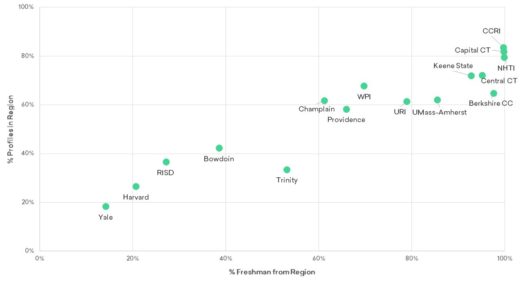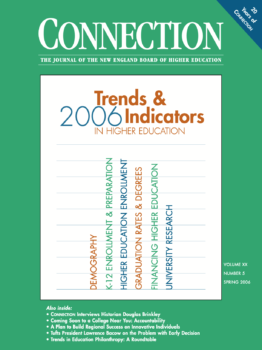 New England colleges and universities are often presented as a source of economic advantage in the New England states for providing a strong talent pool for regional employers. Yet, many state officials and others are questioning the efficacy of colleges and universities in serving regional labor market needs, as employers across New England are currently experiencing pronounced shortages of skilled workers.
New England colleges and universities are often presented as a source of economic advantage in the New England states for providing a strong talent pool for regional employers. Yet, many state officials and others are questioning the efficacy of colleges and universities in serving regional labor market needs, as employers across New England are currently experiencing pronounced shortages of skilled workers.
Regional groups such as the New England Board of Higher Education (NEBHE), the Federal Reserve Bank of Boston and the New England Council (NEC) have key roles to play in addressing this challenge.
A so-called brain drain problem is frequently cited. This is cued in part by the relatively low percentages of New England high school graduates going to a college in their home states. All the New England states are in the bottom quintile in the percentages of high school graduates staying in state to go to college, all with percentages well below the national average of 72%–from a low of 36% in Vermont to a high of just 60% in Massachusetts (NICHE, 2017). Also of concern is that the region’s colleges collectively have a high percentage–more than four of every 10–of their student population from out of state with inherently weaker connection to the state of college attendance and its labor market. The labor market perils are highlighted by data reported in November 2018 by the Chronicle of Higher Education that eight of the 10 four-year nonprofits with the highest out-of-state employment of graduates are in New England, and analysis identifying a strong positive correlation between New England college percentages of students from the region with percentages of graduates employed in the region. (See Figure 1.)
Yet, while New England high school graduates go to college out of state at high rates, they are very likely to stay within the region to go to college. More than three of every four New England high school students stay within the region to go to college, according to data from the labor market analytics firm Emsi on the fall 2016 entering freshman class, the latest figures available. This is well above the U.S. average for staying in state to go to college. Notably, it is above that for the state of Texas, which, is among the top five states in the retention of high school students going to college but is more than three times the geographic size of the entire New England region (269,000 square miles compared with 72,000). This means that students staying in the New England region to go to college–even when going to college outside of their home state–can be much closer to their home towns and labor markets than a student staying in state in Texas.
Connecting New England college students to careers in the region
With over three-quarters of New England high school grads staying in the region to go to college, and the more than 24,000 students from outside the region starting college in the region as freshmen each year, the most important problem to address is not keeping high school graduates in state to go to college but rather it is more strongly connecting New England college students who are from the region and from outside the region to careers and employers in the region. One challenge, however, is that New England college students are highly dispersed across the region’s large and diverse higher education sector.
There are 33 colleges within the region with more than 1,000 New England high school grads as freshman students each year–from UMass-Amherst with 3,650, to Massachusetts Bay Community College with 1,006. These top destinations for New England college-goers, however, collectively account for less than one-half the total number of New England high graduates at New England colleges, and it is a diverse group. All but one of the top college destinations for New England residents are public institutions. More than half (17) of the top 33 are community colleges, which are key institutions in connecting New England higher education with the economy. The other approximate half include all the public flagships, nine regional publics and one private college, Southern New Hampshire University (SNHU). Each of the 33 institutions counts over three-quarters of their total entering freshman students from New England, except SNHU, where about one-third are from the region.
Another group of 33 colleges in the region with notable numbers of New England high school grads as freshmen ranges from Johnson & Wales University with 986 to Husson University with 577. This second group is also widely dispersed across the region–from all the states in the region except for Vermont—but in contrast to the top 33 is dominated by private institutions (about two-thirds, 19). It also includes seven state universities and seven community colleges.
At the privates, the intermingling of New England high school graduates with out-of-region students is much higher than at the publics. Some private colleges in this second group have high percentages of their student body from New England (e.g., WPI and Providence College, each with over two-thirds). A New England-focused recruitment strategy could be effective at these colleges and help address the labor supply challenges that the region’s declining high school graduating classes presents, by working in a focused manner to have more high school graduates from the region stay in the region to work after college graduation. At other private colleges, such as Harvard University and Boston University, the percentage of students from the region is much lower (21% at Harvard and 31% at BU). To add to the skilled labor supply, recruitment efforts at these colleges should have more of a focus on out-of-region student interests and their reasons for job selection, including for example, varied job and career paths and options after first placement.
The diverse and dispersed high education sector in New England means that it is difficult to base talent-recruitment efforts for New England college students from New England at any single college or in any one state or with just privates or publics or just at four-year colleges. The dispersion of the student population from outside the region is even wider absent the concentration at community colleges (99% of students from the region) and public four-year colleges (89% from the region).
Figure 1: Correlation % of Grads Employed in Region and % of Freshmen from Region at Selected New England Higher Education Institutions
Profile Labor Market State-Destination of Graduates Data Source: Emsi resume and profile analysis, 2018. Profiles used were those updated since 2016. The Emsi profile database is a collection of social and professional profiles that include information about an individual’s employer, job title, skills and certifications and more. It currently includes more than 106 million unique profiles, which have been aggregated and deduplicated from the open web. Sources include major online resume, social networking and professional networking sites where individuals voluntarily share their own information.
Freshman Home-State Data Source: Emsi freshman home state analysis, 2018. Data is derived from the Integrated Postsecondary Education Data System (IPEDS) and reflects the most recent data publicly available (2016 fall freshman enrollment).
Deep and broad regional approach needed
NEBHE convened the Commission on Higher Education & Employability in recognition of the need to take a regional approach to connecting high education to the economy in the region. The Strada-Gallup Education Consumer Survey in 2017 examined the main motivations driving college students’ decisions nationwide to pursue postsecondary education. Employment outcomes were the main motivation for higher education, with 58% reporting job and career outcomes as their primary reason. This is true across all higher education pathways and demographic subgroups. And the focus on work/job market outcomes often intensifies as college students get closer to graduation, and closer to having to pay off student debt and be on their own financially.
The Commission appropriately identified as one of its priorities the provision of more robust and relevant New England local labor market information to college students in the region, to inform their career exploration and inform their job search and post-college job placement. This is consistent with higher education’s mission and role, particularly the public institutions.
There are tools available to better inform New England college students about career pathways/opportunities in New England and encourage college graduates in the region to stay in the region and be a stronger talent pool for employers in New England. One example is Emsi’s Career Coach.
Career Coach enables students to start with interest-based career exploration and then identify the programs at colleges that can set them on a path to accomplish their professional goals. As students navigate Career Coach, they are presented with key labor market data specific to their region, including wages, job growth, in-demand skills and live job postings from local and regional employers. For example, if a college student were to explore Career Coach for New England in November 2018, they would have information about occupations specifically in the region with the highest numbers of job postings–including software application developers, registered nurses, marketing managers, industrial engineers, management analysts, sales managers and accountants–and know specific information about the companies in the region recruiting and what the job requirements are and what the jobs pay. This helps New England college students to connect more strongly to the regional economy.
A New Hampshire model
The Community College System of New Hampshire (CCSNH) has adopted Career Coach. As part of its systemwide implementation, each of the state’s seven community colleges received its own website that matches their unique colors and branding. Each site displays labor market data specific to their service area and includes links to the host college’s program pages. Sharing the same core software also means that students across the state benefit from a consistent and familiar interface, regardless of which college’s site they visit. CCSNH also plans to integrate Career Coach with its enrollment and academic planning systems, leveraging the unique strengths of both platforms to provide students a comprehensive solution for challenges from career exploration to course registration.
Deploying technology and web- and mobile-based info is a good start, but academic changes that will substantively and proactively help students engage with career exploration in New England is essential. For example, several New Hampshire community colleges have adopted an innovative first-year course called “Ethnography of Work,” originally developed by Guttman Community College in New York City. In this course, students visit local employers, use Career Coach and apply principles of ethnography–observing, recording and analyzing a culture (in this case workplace) to produce a written account of an institution and the role, responsibilities and daily life of people (in this case, workers) at the institution–in their exploration of workplaces and future careers. The course provides strong academic based links of course work to practical career information and exploration and earns students transferable social science credits.
Inspired by the University of Hawaii system, New Hampshire colleges also plan to embed Career Coach into core English composition courses, where students will use it to develop and write about their career goals as they relate to employment opportunities in their local college area. And the CCSNH is also working with the state’s Department of Education, encouraging high school counselors and parents (along with students) to take advantage of this resource as they help students explore opportunities to continue learning and working, right in their own backyard. The goal is to facilitate early and broad adoption of tools like Career Coach that can help create stronger connection of high school and college students to the economy in the region.
New Hampshire’s approach suggests the value of having a central, consistent and comprehensive source of labor market and career-academic program information for all colleges and communities in New England. For the region, this would enable students to explore in detail academic programs aligned with their career aspirations and possibilities. It would help to address the outmigration of young talent to outside the region and strengthen the homegrown workforce pipeline to employment in the region. And it could also strengthen the connection of college students from outside the region to the regional economy as college students from outside the region explore career opportunities and connections with employers in their use of Career Coach and also in their curriculum and coursework.
Potential partnership possibilities with use of regionwide Career Coach could be supplemented with information and programing from NEBHE (for higher education information and Regional Student Program tuition break), the Federal Reserve Bank of Boston (for economic info) and the New England Council (for business engagement and partnership).
There will be a need to complement the career coach-type efforts and related academic programing with business-connecting activities such as internships, apprenticeships and other work-based learning at regional employers. This is where the New England Council and other business organizations in the region could be very helpful.
Creative recruitment efforts–based on what we know about where New England high school grads attend college – are also needed. These efforts could include “New England Patriot” recruiting events and nights by regional employers specifically targeted to students who are from New England. Events could focus on students at different types of institutions, for example events focused on community college students in the region (with a focus on jobs requiring more technical and vocational specific training and education), or students at regional public universities (who are more likely to stay in the region than students attending the public flagships).
And there is the opportunity to make targeted effort to strengthen connections to the regional economy for the many students attending colleges in New England who are from outside the region. This could involve “New England career exploration/information” events targeted to students at New England colleges from outside the region. These events could be focused on the attributes of the region–its cultural and recreational resources–and also its diverse and large number of job and career possibilities in exciting and growing fields including biotech, regenerative medicine, advanced composite materials, robotics, data analytics and artificial intelligence to name just a few. And these events could be used in part on introducing different areas in the region to student populations that might not be aware of the opportunities outside of Boston, for example, in Providence, Portland, Burlington, Manchester, New London, Lowell, and other mid- and smaller-sized cities in the region. Many of these events–to address the diverse and dispersed higher ed sector in New England–should be multi-college, metro- or rural-wide area. It could be helpful if NEBHE, the Federal Reserve Bank or NEC hosted these events (or all three jointly hosted). Even when focusing on students from outside the region, it will be difficult for employers to focus on one college or in one state. For example, the top five destination colleges for students from outside the region (SNHU, BU, Northeastern, BC and Harvard) together account for less than one of every six freshman students from outside the region.
What will remain to be done?
There will remain a need to address intra-regional brain drain as the more rural areas of New England do experience out-migration of young people from rural area college deserts to university and college centers. Special efforts will have to be made to “reconnect” college graduates from rural areas to the economies in their home communities. This could involve bringing talent plus jobs back to rural areas, with targeted effort to support students from rural areas in starting their business and bringing their start-ups “back” to their hometowns. Targeted effort could also be made to connect, students at colleges in rural areas to local economies. Efforts that include promotion of entrepreneurship at rural colleges, such as Dartmouth College’s Entrepreneurial Network, which include having college-launched businesses stay based locally, could serve as good models.
The region’s higher education institutions are only as strong a source of competitive advantage as are the connections among colleges and universities and their students to the businesses and industry in the region. A regionwide career coach with connections type approach, that strengthens the connectivity of college students and programs in the region to regional businesses and jobs, can help bolster the region’s economic future.
Ross Gittell is chancellor of the Community College System of New Hampshire. Bob Hieronymus is vice president of business development and partnerships at Emsi.
[ssba]


